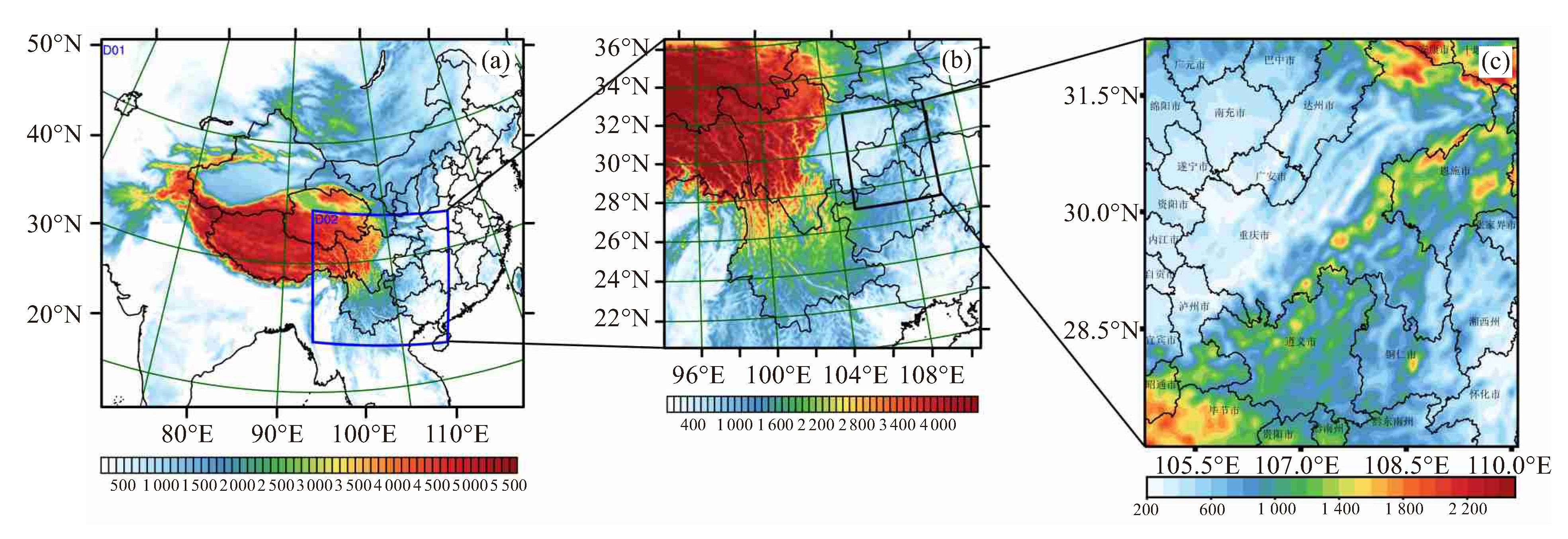Sensitivity Analysis of Different Boundary Layer Parameterization Schemes in High-Resolution Climate Simulation over East of Southwestern China
-
摘要: 为了进一步评估和提高区域模式对西南地区东部高分辨率气候的模拟能力,利用WRF模式,采用多种边界层参数化方案(下称“不同方案”)对西南地区东部1998—2019年夏季降水和气温进行双重嵌套模拟(外层为D01,内层为D02)。对比不同方案模拟结果表明:多年平均降水量在D01中基本为湿偏差;D02中在四川盆地和重庆低海拔地区为干偏差,湿偏差主要位于贵州和重庆的城口、石柱和武隆一带的地形复杂区;总体上D01中ACM2方案误差最小,D02中MYJ方案误差最小。对多年平均气温的模拟在D01中除了四川盆地一带为暖偏差外其余大部地区基本为冷偏差,D02中大部地区为暖偏差;总体上D01和D02中MYJ方案误差最小,YSU方案最大。对于降水量和平均气温年际变化的模拟技巧在D01和D02中相对较高的地区均集中在重庆中西部和湖北大部地区;降水量总体为YSU方案最高,MYJ方案最低;平均气温总体为MYJ方案最高,ACM2方案最低。因此,提升模式分辨率至对流尺度后对不同气象要素模拟技巧最优的方案存在差异,需根据业务情况选择适合本地的参数化方案。Abstract: To further assess and enhance the capabilities of regional models for high-resolution climate simulation in the east of Southwestern China (ESWC), the present study investigated two nested simulations (with D01 as the outer domain and D02 as the inner domain) of summer rainfall and temperature over the ESWC from 1998 to 2019. These simulations were conducted using the Weather Research and Forecasting (WRF) model coupled with various boundary layer parameterization schemes. The findings indicated that different parameterization schemes can lead to biases in the simulated mean annual rainfall. Specifically, the D01 domain exhibited a noticeable wet bias, while the D02 domain showed a dry bias in the Sichuan Basin and the lower altitudes of Chongqing. A wet bias was predominantly found in the complex terrain areas of Chengkou, Shizhu and Wulong in Chongqing, as well as in Guizhou. Overall, the YSU scheme in D01 and the MYJ scheme in D02 demonstrated the smallest bias in rainfall simulations. Regarding temperature simulations, a noticeable warm bias was present in D01 for the Sichuan Basin, with a cold bias in other areas. In D02, a warm bias was observed for most regions. The MYJ scheme exhibited the least bias, while the YSU scheme showed the greatest bias in both domains. The WRF model skillfully reproduced the interannual variability of rainfall and temperature in the midwest of Chongqing and most of Hubei. The YSU scheme outperformed others in rainfall simulation, while the MYJ scheme excelled in temperature simulation. These results suggest that the choice of an optimal scheme may vary depending on the meteorological parameter of interest, especially after model resolution is enhanced to the convective scale. Therefore, it is crucial to select the most suitable local scheme based on operational requirements.
-
图 4 同图 2,但为平均气温
单位:℃。
图 5 同图 3,但为平均气温
单位:℃。
图 7 同图 6,但为平均气温
表 1 参数化方案设定表
参数化方案 D01 D02 区域设计方案 水平分辨率:15 km,格点数:383(经向)×334(纬向) 水平分辨率:5 km,格点数:367(经向)×358(纬向) 微物理方案 WSM6 WSM6 长波辐射方案 New Goddard New Goddard 短波辐射方案 New Goddard New Goddard 边界层方案 YSU/MYJ/ACM2 YSU/MYJ/ACM2 积云对流方案 GF 无 陆面过程 Noah Noah 表 2 不同方案模式模拟西南地区东部夏季区域平均降水年际变化相关系数和均方根误差表
区域 参数化方案 相关系数(R) 均方根误差(RMSE) JJA JUN JUL AUG JJA JUN JUL AUG D01 ACM2 0.47** 0.28 0.24 0.29 2.16 2.76 2.71 2.72 YSU 0.55*** 0.31 0.23 0.39* 2.41 3.5 2.97 2.62 MYJ 0.39* 0.05 0.18 0.52** 3.2 4.75 3.09 3.2 D02 ACM2 0.33 0.26 0.03 0.2 1.43 1.76 2.77 2.15 YSU 0.51** 0.34 0.19 0.44** 1.25 2.03 2.79 1.87 MYJ 0.36* -0.06 0.05 0.62*** 1.34 2.97 2.61 1.52 注:*、**和***分别为通过0.1、0.05、0.01显著性检验。 表 3 同表 2,但为平均气温
区域 参数化方案 相关系数(R) 均方根误差(RMSE) JJA JUN JUL AUG JJA JUN JUL AUG D01 ACM2 0.37* 0.49** 0.3 0.49** 0.84 0.86 1.63 1.45 YSU 0.45** 0.55*** 0.18 0.55*** 0.62 0.81 1.02 1.35 MYJ 0.58*** 0.6*** 0.22 0.69*** 0.63 0.72 0.95 1.24 D02 ACM2 0.45** 0.52** 0.24 0.52** 1.04 1.24 1.62 1.09 YSU 0.48** 0.57*** 0.25 0.59*** 1.22 1.44 1.73 1.12 MYJ 0.62*** 0.63*** 0.29 0.74*** 0.96 1.11 1.5 0.89 注:*、**和***分别为通过0.10、0.05、0.01显著性检验。 -
[1] JANG X W, YANG S, LI Y Q. Seasonal to interannual prediction of the Asian summer monsoon in the NCEP climate forecast system version 2[J]. J Climate, 2013, 26(3): 3 708-3 727. [2] KIM H M, WEBSTER P J, CURRY J A. Seasonal prediction skill of ECMWF System 4 and NCEP CFSv2 retrospective forecast for the Northern Hemisphere Winter[J]. Clim Dyn, 2012, 39: 2 957-2 973. [3] YANG X L, ZHOU B T, XU Y, et al. CMIP6 evaluation and projection of temperature and precipitation over China[J]. Adv Atmos Sci, 2021, 38: 817-830. [4] LANG Y, YE A Z, GONG W, et al. Evaluating skill of seasonal precipitation and temperature predictions of NCEP CFSv2 forecasts over 17 hydroclimatic regions in China[J]. J Hydrometeorology, 2014, 15: 1 546-1 559. [5] GIORGI F. Thirty years of Regional Climate Modeling: Where are we and where are we going next?[J]. J Geophys Res Atmos, 2019, 124, 5 696-5 723. [6] GAO X J, GIORGI F. Use of the RegCM system over East Asia: Review and perspectives[J]. Engineering, 2017, 3(5): 766-772. [7] 刘燕, 王谦谦, 程正泉. 我国西南地区夏季降水异常的区域特征[J]. 大气科学学报, 2002, 25(1): 105-110. [8] 马振峰, 谭友邦. 预测川渝地区汛期降水量的一种物理统计模型[J]. 大气科学, 2004, 28(1): 138-145. [9] 蒋兴文, 李跃清, 李春, 等. 四川盆地夏季水汽输送特征及其对旱涝的影响[J]. 高原气象, 2007, 26(3): 476-484. [10] 李永华, 徐海明, 刘德. 2006年夏季西南地区东部特大干旱及其大气环流异常[J]. 2009, 气象学报, 67(1): 122-132. [11] 李永华, 徐海明, 白莹莹, 等. 我国西南地区东部夏季降水的时空特征[J]. 高原气象, 2010, 29(2): 523-530. [12] 李永华, 徐海明, 高阳华, 等. 西南地区东部夏季旱涝的水汽输送特征[J]. 气象学报, 2010, 68(6): 932-943. [13] 李永华, 卢楚翰, 徐海明, 等. 夏季青藏高原大气热源与西南地区东部旱涝的关系[J]. 大气科学, 2011, 35(3): 422-434. [14] 李永华, 向波, 卢楚翰, 等. 热带大气季节内振荡对西南地区东部夏季降水的影响及其可能机制[J]. 大气科学, 2016, 40(2): 437-450. [15] 罗小青, 杨梅学, 王学佳, 等. 两种积云参数化方案对青藏高原夏季降水影响的模拟[J]. 高原气象, 2014, 33(2): 313-322. [16] 何光碧, 彭俊, 屠妮妮. 基于高分辨率地形数据的模式地形构造与数值试验[J]. 高原气象, 2015, 34(4): 910-922. [17] 潘留杰, 张宏芳, 王建鹏, 等. 日本高分辨率模式对中国降水预报能力的客观检验[J]. 高原气象, 2014, 33(2): 483-494. [18] 吴遥, 李跃清, 蒋兴文, 等. WRF模拟青藏高原东南部极端旱涝年降水的参数敏感性研究[J]. 高原气象, 2017, 36(3): 619-631. [19] 叶笃正, 李崇银, 王必魁. 动力气象学[M]. 北京: 科学出版社, 1988: 138-153. [20] 伍荣生. 大气动力学[M]. 北京: 高等教育出版社, 2002: 165-203. [21] 沈桐立, 田永祥, 葛孝贞, 等. 数值天气预报[M]. 北京: 气象出版社, 2003: 303-304. [22] HU X M, NIELSEN-Gammon J W, ZHANG F Q. Evaluation of three planetary boundary layer schemes in the WRF model[J]. J Appl Meteor Climatol, 2010, 49(9): 1 831-1 844. [23] KLEIN C, HEINZELLER D, BLIEFERNICHT J, et al. Variability of West African monsoon patterns generated by a WRF multi-physics ensemble[J]. Climate Dyn, 2015, 45(9): 2 733-2 755. [24] 王子谦, 段安民, 吴国雄. 边界层参数化方案及海气耦合对WRF模拟东亚夏季风的影响[J]. 地球科学, 2014, 44(3): 548-562. [25] KALA J, ANDRYS J, TOM J, et al. Sensitivity of WRF to driving data and physics options on a seasonal time-scale for the southwest of Western Australia[J]. Climate Dyn, 2015, 45(3): 633-659. [26] 师春香, 潘旸, 谷军霞, 等. 多源气象数据融合格点实况产品研制进展[J]. 气象学报, 2019, 77(4): 774-783. [27] MELLOR G L, YAMADA T. Development of a turbulence closure model for geophysical fluid problems[J]. Rev Geophys Space Phys, 1982, 20(4): 851-875. [28] PLEIM J E. A combined local and nonlocal closure model for the atmospheric boundary layer. PartⅠ: Model description and testing[J]. J Appl Meteor Climatol, 2007, 46: 1 383-1 395. [29] HONG S Y, LIM J J. The WRF single-moment 6-class microphysics scheme (WSM6)[J]. Korean Meteorol Soc, 2006, 42: 129-151. [30] 李娟. 四川盆地夜雨的时空变化特征及形成机理研究[D]. 南京: 南京信息工程大学, 2021: 58-78. -






 下载:
下载:








 粤公网安备 4401069904700003号
粤公网安备 4401069904700003号